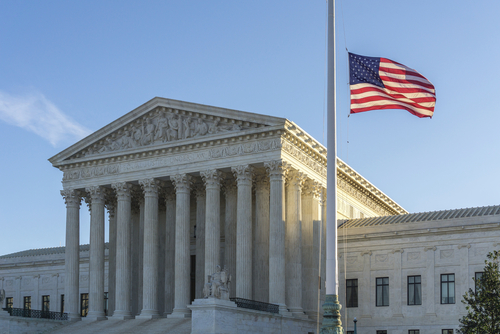Supreme Court decision in ‘travel ban’ case will have far-reaching impact
On Wednesday, the Supreme Court focused on the president’s executive power to limit immigration from designated foreign countries to ensure the safety of our own. Afterward, most court-watchers agreed that a majority of the court appears poised to answer the legal questions in President Trump’s favor, but those court-watchers may be getting ahead of themselves by reading too much into some oral argument questions and not enough into others.
At issue before the court is the Trump administration’s so-called “travel ban” — the president’s executive order suspending entry, with some exceptions, of certain categories of aliens from eight foreign countries that “do not share adequate information with the United States or that present other risk factors.”
This order has been one of the most politically fraught and hotly contested issues of Trump’s presidency. But as always, it’s wise to focus not on the potential political fall-out of the issue, but on the more far-reaching implications of the legal questions at hand.
The key questions the justices must address: Is it a lawful exercise of the president’s authority to suspend entry of aliens abroad for purposes of national security? Or does Trump’s order represent an unconstitutional breach of the First Amendment’s Establishment Clause, motivated by religious animus towards Muslims?
Early in the argument, Justice Kagan suggested a hypothetical scenario designed to probe those questions. She asked U.S. Solicitor General Noel Francisco, the attorney representing the administration, to address a circumstance in which a president prone to “anti-Semitic” commentswere to ask his staff to prepare an order prohibiting entry of Israelis to America.
The attorneys for both sides, and a majority of the justices, appeared to conclude that even this hypothetical president’s powers would be upheld if agencies had neutrally and fairly determined that Israelis posed an unwarranted risk to national security — as long as exceptions to a blanket ban were allowed.
In fact, much of the questioning focused on this point: whether the actual travel prohibition before the court sufficiently allowed for such exceptions in the form of waivers of the prohibition on a case-by-case basis. Justice Breyer, in particular, seemed to suggest that if it did, then that could be the end of the matter as he saw it.
Breyer noted that both Presidents Ronald Reagan and Jimmy Carter issued proclamations similar to Trump’s, and unless the Trump proclamation was materially different, then he did not see how Trump could not lawfully follow suit. Francisco agreed, pointing out that waivers and case-by-case review are set out in the text of the current proclamation at the heart of the case.
In questioning Neal Katyal, the attorney leading the challenge to the president’s order, the justices focused on amicus briefs claiming the waiver process is nothing more than “window dressing” to make an unlawful proclamation lawful. Katyal struggled to overcome the fact that the latest version of the travel ban, as reformulated by the Trump administration after earlier challenges, explicitly calls for agency heads to consider waivers if a traveler is judged to pose no risk to national security.
In previewing the oral argument earlier this week, I noted that, based on previous terrorism cases, a majority of the justices is unlikely to elevate national security over the principles protected by the Bill of Rights. Likewise, Katyal relied on those earlier cases to argue his cause.
But this case may be different, because of the waiver and case by-case review opportunity included in the president’s detailed proclamation. The detainees in the earlier terror cases did not have a similar alternative to the extra-legal process a majority of the court found otherwise objectionable. If the tenor of Wednesday’s oral argument is any guide, then the waiver and review process — not included within the original, and much less detailed, travel ban — could lead to a successful outcome at the high court for the president’s side.
Certainly, not all members of the court focused on the waiver procedure that Breyer emphasized. Some justices appeared to agree with Francisco that in this matter of national security, judicial review was not just unnecessary, it was precluded by the separation of powers.
Moreover, Justice Alito explicitly appeared to reject the notion that the president’s proclamation was designed to “ban” Muslims. He pointed out that while there are perhaps 50 majority Muslim nations in the world, this order applies only to a few. But to reach a decision upholding the president’s powers, it is likely the justices will have to resolve Breyer’s concerns in favor of the president.
And where Justice Kennedy stands may remain an open question. Kennedy made comments that both sides could take solace in. He dismissed Katyal’s argument that this proclamation was “perpetual” because it did not have a sunset provision, suggesting that to insert such a provision the president would have to be “convinced in six months that we’re going to have a safe world.”
But on the other hand, Justice Kennedy also struggled with Francisco’s argument that a candidate could make hateful statements on the campaign trail, take action after election seemingly consistent with those statements, and then not be held accountable because the intervening election had washed the taint of those statements away.
Overall, based on the questions and answers offered at the court, Trump should be grateful both to Francisco, who argued the administration’s case with vigor, and to the attorneys who refashioned the original “travel ban” into the proclamation under review by the court. Because that argument, and the differences between the two proclamations, may carry the day for this president — and will have a far-reaching impact on his successors, who will be required to work within the strictures of the Supreme Court’s ultimate decision.
Mark Miller is a senior attorney for Pacific Legal Foundation, which litigates nationwide to achieve court victories enforcing the Constitution’s guarantee of individual liberty.

